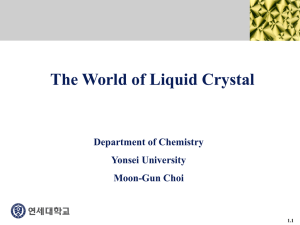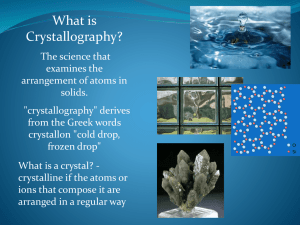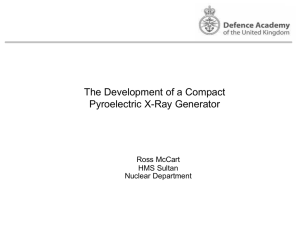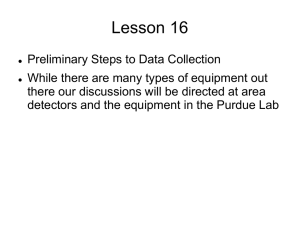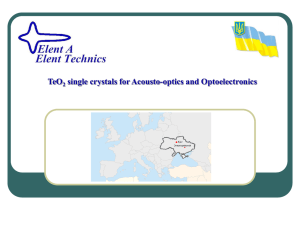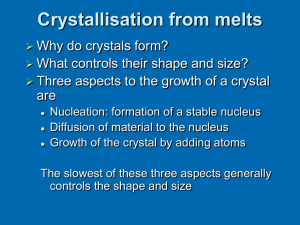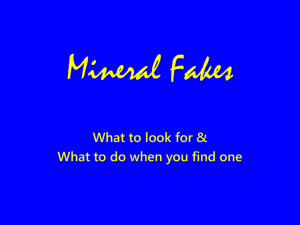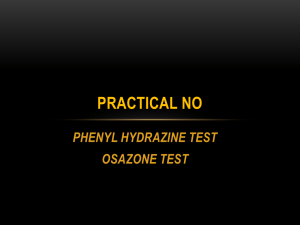I agree
advertisement
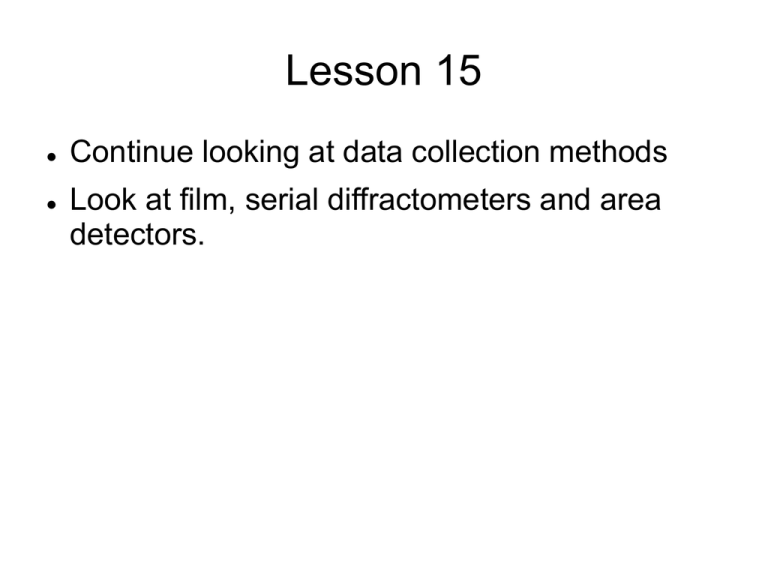
Lesson 15 Continue looking at data collection methods Look at film, serial diffractometers and area detectors. Submitting Crystals You can bring your crystals to the lab in three different ways 1. Dry 2. In the mother liquor 3. In a protecting liquid such as Paratone-N Submit the on-line form and label the crystal container so it can be matched to the sample name Selecting Crystals Crystals should have well defined faces. They should have smooth faces without imperfections. Should not be larger than 0.5mm in the longest direction. Can usually cut crystals. For the Rigaku diffractometer no bigger than 0.2mm. If light goes through them they should be examined under a polarizing microscope. Obviously must make accommodations for the real world. Polarizing Microscope General Position Interference Colors A function of the thickness of the crystal and the difference in the refractive indices in the two directions. As crystals get thicker these colors disappear. The more light that comes through the better the crystal Layered crystals will not be bright because of internal reflection between the layers. Extinction Some Comments on Extinction Cubic crystals are isotropic and hence always dark between crossed polarizers! Hexagonal, trigonal and tetragonal crystal have an isotropic axis (c). When looked at down that axis the crystals will always be dark. In triclinic and most faces in monoclinic crystals the extinction directions may be a function of wavelength. Instead of going black they will get dark blue then go dark red or vice versa. This is ok Some crystals change colors under one polarizer—dichroism. Selecting a Crystal It is worth spending some time with the microscope to get the best crystal. Make sure the crystal is representative of the batch. Size is not as important as quality Remember—The quality of the final structure depends almost entirely on the quality of the crystal studied! Goniometer Head Crystal Mounting Crystals were typically mounted on a glass or quartz fiber. Since these materials are not crystalline they do not diffract but they can scatter the beam. Lately using nylon loop mounts from Mitegen Crystals can be glued to the fiber with epoxy, super glue, or thermal glue for room temperature work. For low temperature work or using loops grease (Apeazon H) can be used. Magnetic Caps Fiber is glued into copper tube. A magnet on the goniometer head holds the cap in place Can easily and quickly be removed from diffractometer Mitegen Nylon Mounts Collecting Data Must determine the intensity and su for each reflection. The intensities go from a few counts to maybe a million counts (dynamic range) Noise is a problem. If the signal is less than the noise then no matter how long the reflection is measure it will be unobserved! Included in noise is the intensity of the background Types of Detectors • • • Film with some camera Serial Diffractometer with a scintillation detector Area Detectors – – Image plate CCD Film • • • To use film you need some way to spread the spots so they can have hkl assigned. The precession camera was described A second type of camera, the Weissenberg camera can also be used. Film Methods Rotation Photograph Weissenberg Photos Problems Must align about a real axis Alignment is fairly fast. Exposure takes days. Picture is hard to read. Film is curved so Polaroid film cannot be used How to get data? Must determine the intensity of the spots. To do this must compare the intensities to some scale. To expand the range the camera holds six films. The front one is used for weak reflections while the last one is used for strong reflections The six films are scaled by common spots. How do you determine standard uncertainty? Very tedious and inexact. Using Film Very low background –can take very long exposures Fairly sensitive to radiation Covers a wide area. Obviously slow to expose and must be developed Very tedious to measure the intensities. No one uses today—in fact x-ray film is no longer available. Speeding it Up The biggest problem with film is obtaining intensity data. Can use something like Geiger counters or scintillation detectors to count the radiation. Since these detectors have no spatial discrimination only allow a small area to reach the detector Must move the crystal precisely so the scattered wave lands on the detector. Serial Diffractometer The result is the serial diffractometer. This is a very precise instrument that allows one to position the crystal in nearly any position It consists of 4 movable angles that intersect to better than 0.01mm. Phi ±0.015° Kappa, Omega, 2Theta ±0.010° Reproducibility ±0.005° Resolution 0.0003° Eulerian Cradle Four Angles Phi—rotates the goiniometer head Chi –rotates the image around the beam Omega—used to make things more convenient Two Theta—the detector They are called the Eulerian Angles. Problems Hard to keep in alignment Hard to move phi as it rotates around chi. The chi circle is closed at the top making it harder to bring in low temperature device. The chi circle will run into either the beam or the detector limiting settings. Kappa Geometry Kappa Geometry Can convert from kappa to Eulerian angles Open on top Mechanically much simpler Cannot reach chi angles above 110° CAD4 CAD4 Using Serial Diffractometers Must know where the spots are so they can be collected. Must index the crystal before starting data collection. From previous photos From Polaroid photos taken on the diffractometer From random searches. Must accurately determine the angles of the spots to determine the cell constants. Orientation Matrix The key to automated data collection is the orientation matrix. This is the three reciprocal vectors projected on some Cartesian coordinate system of the instrument. Thus the length of each column is a*, b*, and c* The angle between column 1 and 2 is γ* etc. Eulerian Cradle Using the Orientation Matrix Any diffraction vector d for a (h,k,l) is simply calculated by d= ax ay az bx by bz cx cy cz h k l Once you have d you can calculate the setting angles. Data is scanned point by point. A background and data are collected. Usually data is collected by scanning through the peak. Problems with Serial Diffractometers Still slow. Can collect maybe 2500 reflections a day. A typical data set takes several days to a week to collect. The detector is fairly noisy and therefore very long exposure times are impossible as the signal does not become larger than the noise. Since only a small region of space is exposed frequently get incorrect unit cells or data that will not index. Area Detectors. Looking for electronic film. Can determine the hkl from location and intensity by pixel intensities. Since an area is scanned at one time many data are collect simultaneously. Several Approaches. Image Plates This is a material that emits visible light when scanned by a laser in proportion to how much xray exposure it receives. Very low noise and very large dynamic range. Not a real-time device. Mainly used in macromolecular work though the main instrument in the Purdue Lab is an image plate system. Rigaku R-axis Small Molecule Rapid II Image Plate Advantages – Huge dynamic range—cannot saturate – Can have any shape and be any size – Much better resolution – No noise except from readout – Simple mechanically and electronically Disadvantages Readout is slow—about 2 minutes Less flexible Charged Coupled Device The ccd is essentially a digital camera To keep noise down it is cooled It is almost real-time. Does not have as low a noise level as image plate but is much better than scintillation detector. Does not detect x-rays but light emitted by a phosphor. Kappa CCD KappaCCD Specs Screen 63.5 x 63.5 mm Pixels 621 x 576 (binned) Pixel size 110 x 110 µm (binned) Distortion <2 % Phosphor 25 mg/cm² Gd2O2S, optimized for Mo. Option optimized for Cu: 10 mg/cm² Taper, magnification 2.45:1 CCD EEV, CCD05-30 grade 1 Dark current 0.02 e/s.pix Cooling CCD -60 °C About 8 electrons/photon Readout Noise about 1 electron Readout time 3 seconds Newer Developments Very large CCD chips that do not need taper. These are 16 Mega pixel chips. Much more sensitive with improved signal to noise (over 200 electrons/photon). Elimination of taper increases the signal Read out is faster. In the last year moved to cmos detectors—each pixel can be read out individually CCD • Advantages – – • Faster readout More Flexible setup Disadvantages – – – – Limited 2 theta range More complex mechanically (cooling) and electronically Noisier Lower dynamic range The X-ray Lab Rigaku Rapid II on a MicroMax002+ micro source. A Nonius KappaCCD Software: Nonius Collect Package EvalCCD HKL2000 – used by both instruments Rigaku Crystal Clear RAPID KappaCCD


